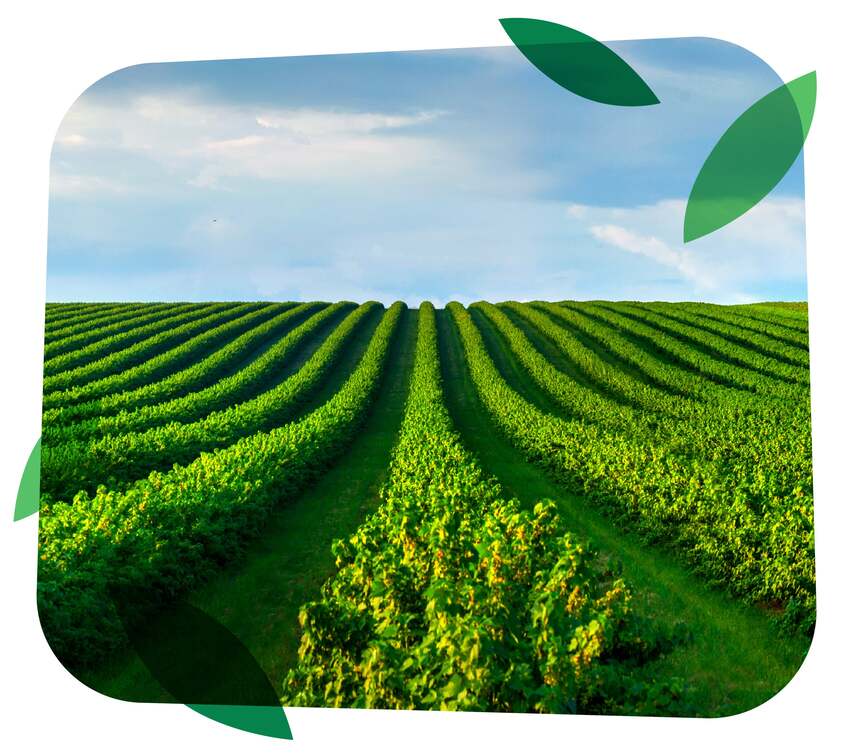By following our fertilization recommendation and using Haifa's fertilizers, the oil palm meets its nutrients requirements
Plant population: 128-148 trees /Ha.
Expected yield: 10-18 t/ha FFB (mature fresh fruit bunches).
First harvest at good development conditions is expected 32-38 months from planting.
Economic life of the plantation is 20-25 years.
Common nutrient deficiencies
N deficiency is usually associated with waterlogging, heavy weed infestation and topsoil erosion. It will result in general paling and stiffening of the pinnae which lose their glossy lustre, reduce the number of effective fruit bunches, as well as the bunch size. P deficient leaves are shorter than well-nourished ones. Bunch size and trunk diameters are reduced. K deficiency is very common, and is the major yield constraint in sandy or peaty soils. The most frequent symptom is pale green spots appearing on the pinnae of older leaves. As deficiency intensifies these spots turn orange, or reddish-orange, and dessication sets in, starting from the tips and outer margins of the pinnae. In soils with low water holding capacity K deficiency can lead to a rapid premature dessication of fronds.
Recommended average rates of nutrients for mature oil palm trees (over 6 years).
Nutrients requirements & best methods to meet them
|
Nutrients requirements (Kg/Ha/Year) |
Recommended fertilizers (Kg/Ha/Year) |
||||||
|---|---|---|---|---|---|---|---|
|
N |
P2O5 |
K2O |
MgO |
Kcl |
AN |
||
|
110-155 |
64-98 |
230-445 |
10-21 |
365-705 |
105-160 |
271-383 |
62-131 |
Nitrogen - In case of high N fertilization, N should be split into several dressings. In areas with an extended dry period, the last N application should be at least 3-4 months before the beginning of the dry season, because high N levels in the leaves result in increased water consumption.
Phosphorous - water-soluble sources are preferred during the immature phase.
Potassium - should be spread over the circle around young trees. For mature trees it is preferable to broadcast in the inter-row.
Modifications for young, non-bearing plantations:
- When dry application is practiced, the fertilizers should be evenly spread around the young trees.
- Multi-K (potassium nitrate) is the preferred source of potassium for this phase, for both seasons since it will contribute to earlier shift to productive phase.
- The following guide-line may be utilized for the non-bearing phase.
|
Year |
Multi-K |
MAP |
AN |
Magnisal |
|---|---|---|---|---|
|
1 |
11 |
5 |
9 |
2 |
|
2 |
22 |
8 |
9 |
4 |
|
3 |
33 |
11 |
17 |
6 |
|
4 |
45 |
15 |
35 |
8 |
|
5 |
85 |
17 |
20 |
10 |
Multi-K = Potassium Nitrate (13-0-46) .
AN = Ammonium Nitrate (34% N).
MAP = Ammonium Phosphate (12% N and 61% P2O5).
Magnisal = Magnesium nitrate (11-0-0+16MgO).
Nutrient uptake of oil palm - Malaysia
Source: Research Projects --- Interpretive Summaries
Potash & Phosphate Institute (PPI)
655 Engineering Drive, Suite 110 Norcross, GA 30092-2843
Phone: 770-447-0335; Fax: 770-448-0439
East and Southeast Asia Program
Dr. Ernst Mutert, Director
Project Leader: Kabul Pamin
Reaching the yield potential of clonal oil palms requires high application rates of P and K during early tree development. Part of the yield opportunity results from earlier fruit bunch development (at 18-20 months compared to 30-36 months of age). Fruit bunch development is related to the rate at which fronds are produced. High K rates were found to increase frond development in six of the 12 clonal palm lines used in this study. Bunch yield data have not been analyzed.
 Fertilization of oil palms
Fertilization of oil palms
Plant population: 20-24 trees/rai.
Expected yield: 1.6-2.9 ton/rai FFB (= mature fresh fruit bunches).
Multi-K = KNO3 = Potassium Nitrate (13-0-46).
AN = Ammonium Nitrate (34% N).
MAP = Mono-Ammonium Phosphate (12% N and 61% P2O5).
Magnisal = Magnesium nitrate (11-0-0+16 MgO).
Recommended average rates of nutrients for mature oil palm trees (6 years and over)
|
Nutrients requirements |
Recommended fertilizers |
||||||
|---|---|---|---|---|---|---|---|
|
N |
P2O5 |
K2O |
MgO |
Kcl |
AN |
||
|
20- |
10-15 |
40-70 |
1.6- |
35-60 |
12-15 |
25-35 |
7-15 |
|
Recommended fertilizers |
|||||||
|
Multi-K |
MAP |
AN |
Magnisal |
||||
|
45-85 |
10-15 |
35-45 |
7-15 |
||||
Modifications for young, non-bearing plantations:
- When dry application is practiced, the fertilizers should be evenly spread around the young trees.
- Multi-K (potassium nitrate) is the preferred source of potassium for this phase, for both seasons since it will contribute to earlier shift to productive phase.
- The following guideline may be utilized for the non-bearing phase.
|
Year |
Multi-K |
MAP |
AN |
Magnisal |
|---|---|---|---|---|
|
1 |
11 |
5 |
9 |
2 |
|
2 |
22 |
8 |
9 |
4 |
|
3 |
33 |
11 |
17 |
6 |
|
4 |
45 |
15 |
35 |
8 |
|
5 |
85 |
17 |
20 |
10 |





